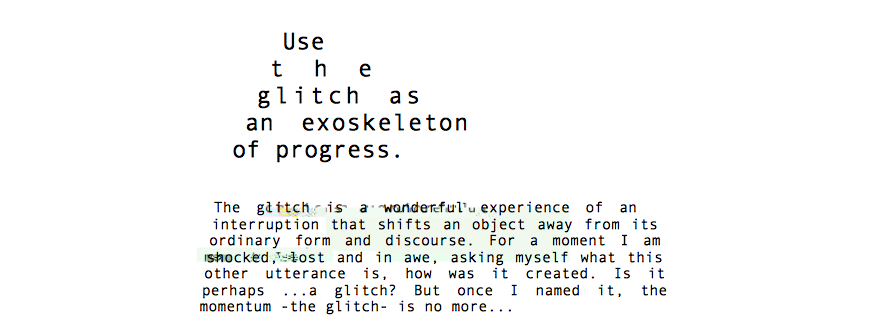Glitch Studies Manifesto
Rosa Menkman’s Glitch Studies Manifesto reads like a sacred text - “In the beginning, there was only noise...” - a phrase that not only evokes dogmatism but one that is quite possibly a cosmological truth. If noise is chaos and chaos preseeded order, like the Taoist origin story tells, then Rosa Menkman is both artists and prophet and Glitch Studies Manifesto is scripture. Like the tower of Babel, Glitch Studies Manifesto warns that the endless search for a noiseless channel is “no more than a regrettable, ill-fated dogma”. The manifesto goes on to define glitch as disintegration, and as such it is the flipside of synthesis and is a positive disruptor in both art and culture.
mage is a screenshot from Glitch Studies Manifesto .pdf - http://amodern.net/wp-content/uploads/2016/05/2010_Original_Rosa-Menkman-Glitch-Studies-Manifesto.pdf
Rosa Menkman is a pioneer of glitch art. Her manifesto is a passionate expression of why glitch is a significant phenomenon whose potential lies within every byte of data. Her visual work features glitch but her manifesto defines its place in culture. Glitch Studies Manifesto goes beyond a definition of glitch, however. It promises hope for what glitch might offer by suggesting disintegration might democratize society.
Image is a screenshot from Glitch Studies Manifesto .pdf - http://amodern.net/wp-content/uploads/2016/05/2010_Original_Rosa-Menkman-Glitch-Studies-Manifesto.pdf
A self-published .pdf, Glitch Studies Manifesto is a postmodern academic essay, visual poetry and an early form of digital poetry. The words on the page are physiognomic, taking on shapes unusual in traditional writing. Throughout, glitches warp the text making the hidden words seem profoundly significant. Like Menkman teaches, glitching both hides and highlights the manipulated forms.
Image is a screenshot from Glitch Studies Manifesto .pdf - http://amodern.net/wp-content/uploads/2016/05/2010_Original_Rosa-Menkman-Glitch-Studies-Manifesto.pdf
Today, glitch has made its way into mainstream Hollywood productions. Video effects artist John Nelson is best known for his work on the Hollywood blockbuster, Blade Runner 2049. He uses glitch to convey the internal dynamics of the characters but he also uses glitch to highlight something Rosa Menkman calls “digital noise artifacts”. In the film, pieces of today’s culture are presented as decaying artifacts, showing the impermanence of our current moment in time. When asked about this use of glitch, such as the kind of artificial glitch effects used in Blade Runner 2049, Menkman is not as dogmatic as her manifesto might suggest.
“I am excited about the new vernaculars and meanings glitch aesthetics have obtained. I feel lucky to have observed this development in the visual arts from the very beginning - when a glitch was just scary - to today, when glitches are used in blockbusters such as Blade Runner 2049, to signify computational errors, AI, or the loss of control, depending on the scene. I am fine with that development, its a strong case study of how what once were experiments have become part of a mainstream culture.”
Rosa Menkman’s Glitch Studies Manifesto is presented as visual poetry, a style of writing where words are arranged unconventionally on the page. The added glitch effects make the manifesto fit into another aesthetic category, digital poetry. Like visual poetry, the words break free from the formats that would otherwise bind them and digital elements are added to the work. Artist Judd Morrissey’s work, The Last Performance, is a digital poem that began as an animation but has been realized in a variety of forms.
Image courtesy of Electronic Literature Collection - http://collection.eliterature.org/2/works/morrissey_last_performance/Morrissey_ELO/installation/
Morrissey’s poem is about the Hagia Sophia, a Byzantine cathedral turned mosque, then museum in Istanbul, Turkey. The words in the poem provide both meaning and reference to the physical shapes of the cathedral. The dome, for example, is represented by text that is arranged a circular perspective like a dome. Each phrase is a link to an alternate version of the poem. In a 2008 performance, a dot matrix printer exported frames from the poem, bringing the digital into physical.
Image courtesy of Electronic Literature Collection - http://collection.eliterature.org/2/works/morrissey_last_performance/Morrissey_ELO/installation/
Glitch is a recent discovery and Menkman, an early pioneer, is working on some new projects regarding resolutions. This is an approach to glitch that she has been exploring for some time. As she argues in her manifesto, there is no knowledge without nonsense, there is no familiarity without the uncanny and there is no order without chaos.
http://rosa-menkman.blogspot.com
https://onlinelibrary.wiley.com/doi/pdf/10.1111/oli.12112
https://en.wikipedia.org/wiki/Digital_poetry
https://www.altsalt.com/4-digital-poems/
http://collection.eliterature.org/2/works/morrissey_lastperformance.html
https://www.creativebloq.com/features/behind-the-scenes-of-blade-runner-2049
https://www.imdb.com/name/nm0625471/
https://en.wikipedia.org/wiki/Blade_Runner_2049










